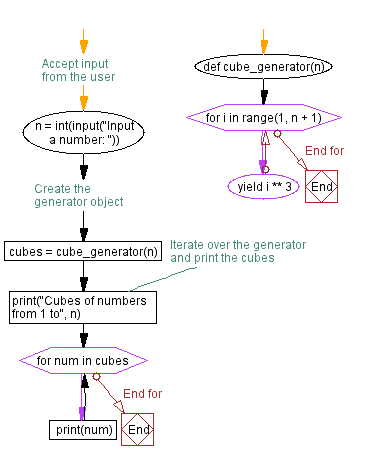Python Generators: Yielding cubes from 1 to n
1. Cubes Generator
Write a Python program that creates a generator function that yields cubes of numbers from 1 to n. Accept n from the user.
Sample Solution:
Python Code:
def cube_generator(n):
for i in range(1, n + 1):
yield i ** 3
# Accept input from the user
n = int(input("Input a number: "))
# Create the generator object
cubes = cube_generator(n)
# Iterate over the generator and print the cubes
print("Cubes of numbers from 1 to", n)
for num in cubes:
print(num)
Sample Output:
Input a number: 10 Cubes of numbers from 1 to 10 1 8 27 64 125 216 343 512 729 1000
Explanation:
In the above exercise -
- Inside the "cube_generator()" function, a for loop iterates over the range of numbers from 1 to n + 1. For each number i, it calculates the cube by raising i to the power of 3 using the ** operator.
- Instead of using the return statement to return the cube value, it uses the yield keyword. This makes the function a generator, allowing it to generate and yield one cube value at a time when requested.
- The program prompts the user to input a number using the input() function. The input value is then converted to an integer using int() and stored in n.
- The generator object "cubes" is created by calling the cube_generator function with n. This sets up the generator and prepares it for iteration.
- The program then iterates over the "cubes" generator using a for loop. For each iteration, the next cube value is generated and assigned to the variable num.
- The cube values are printed one by one inside the loop using print().
Flowchart:

For more Practice: Solve these Related Problems:
- Write a Python function that yields cubes of numbers from 1 to n and prints the cube for each number.
- Write a Python program that uses a generator to produce cubes from 1 to n, then sums these cubes and prints the result.
- Write a Python script that generates cubes using a generator and outputs the cubes in a single comma‐separated string.
- Write a Python program that yields cubes from 1 to n and filters out cubes that are even before printing them.
Go to:
Previous: Python Generators Yield Exercise Home.
Next: Python random number generator using generators.
Python Code Editor:
Contribute your code and comments through Disqus.
What is the difficulty level of this exercise?
Test your Programming skills with w3resource's quiz.
